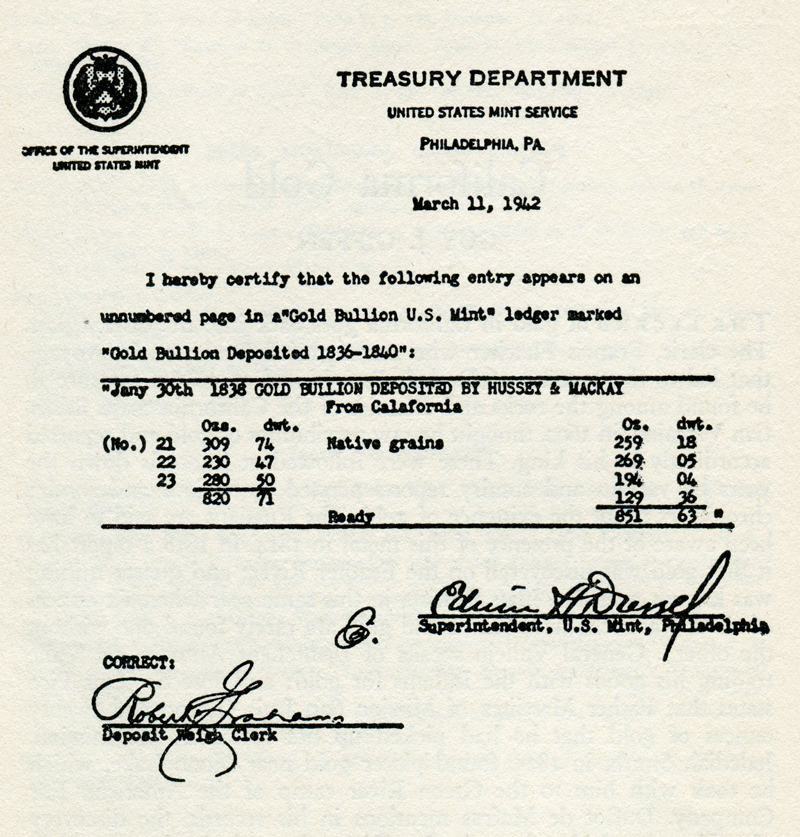|
|
California Gold.
By Guy J. Giffen
The Quarterly | Historical Society of Southern California | March 1948
|
The legend of gold in California goes back into the distant past. The cleric, Francis Fletcher who accompanied Drake on his voyage that led to the naming of Drake's Bay, hinted at golden treasure to be found among the rocks and crannies of the California coast. Sebastian Vizcaino, in 1602, thought he saw possibilities of gold and reported accordingly to his king. These were followed at intervals down the years by various and sundry reports penned by various and sundry chroniclers about the existence of gold. The Russians are said to have been aware of the presence of this metal in 1814. In 1818 a report has it that gold was discovered on the Feather River; and quartz mining was known near San Juan Bautista in this same year when six ounces of silver was reclaimed, (silver and gold are rarely found one without the other). General Vallejo speaks of Lieutenant Antonio del Valle trading his goods with the Indians for gold; and Jose de Jesus Pico states that Father Martinez of Mission San Luis Obispo had twenty ounces of gold that he had picked up not far from the mission. Jedediah Smith, in 1825, found placer gold near Mono Lake, which he took with him to the Green River camp of the American Fur Company. Duflot de Mofras mentions in his records, the discovery of gold at San Isidro (now in San Diego County), in the year 1828. These accounts may all be true but they have not been substantiated. In the early 1830s some gold was brought into California for the purpose of trade, later being shipped east (principally to Boston), and earning for California the unwarranted reputation of being a gold producing country. Heretofore the year 1842 has generally been accepted as the discovery date of gold in California. This refers to the finding of gold in Placerita Canyon, March 9, 1842, by Francisco Lopez, when he pulled a wild onion to eat with his lunch. Gold from Placerita was sent to the Philadelphia Mint in November, 1842, by Abel Stearns, in the care of Alfred Robinson; and in August, 1843, the Mint returned the following: "Before melting, 18 34-100 oz. After melting, 18 1-100 oz. Fineness 926-1,000; value $344.75." This find antedates the discovery of gold at Sutter's Mill by nearly six years, for it was January 24, 1848, that Marshall made the find that echoed around the world. However, both 1842 and 1848 will have to bow to a still earlier date. While endeavoring to trace this history of the shipment of "one lump of gold, value unknown," recorded on a waybill of the year 1836, which was in the possession of Mrs. Edith Gragg of San Luis Obispo, and later in the hands of her brother, Captain Ryland Drennan, of San Francisco, another interesting bit of information was discovered. Through correspondence with the Philadelphia Mint on the above subject, it was brought to light that the date of the receipt of the first shipment of California gold was January 30, 1838, when Hussey and Mackay handed in 851 oz. 63 dwt. of California native grains, (placer gold). After melting the gold weighed 820 oz. 71 dwt. or approximately $16,000. It might be added that the Mint can tell definitely the state and district from which gold comes, in some instances down to the individual mine. As to Hussey and Mackay who were the despositors of this gold. Considerable research has brought to light the fact that this firm of brokers was doing business in New York from 1836 to 1844, housed at 62 South Street. In 1844 George Mackay died, and the firm became Hussey and Murray in 1845, and Hussey, Bond and Hale in 1854. George F. Hussey died in Peekskill, N.Y., in 1859. Just how this firm came into possession of these grains has not been determined. A letter from Mabel Gillis, Librarian of the California State Library may throw some light on the subject. One Thomas McKay was an employee of the Hudson [sic] Bay Company. He trapped in the Klamath country, Northern California, as early as 1825 and was in and out of California for a number of years, returning to Vancouver in 1838. In the will of the New York George Mackay he mentions a brother T.R. Mackay, who might or might not have been the Thomas McKay of the Hudson Bay Company. In spite of the difference in the spelling of the name, one might conjecture that he was the relative of the New York broker, and that the gold was sent to him by his brother. There is, of course, no evidence to bear this out. However, the page from the Mint record does establish the fact that gold from California found its way to the United States Mint January 31 [sic], 1838.
|
An Arrastre
1838 Shipment
Pre-1842 Discoveries & Later Mining Techniques, by W.W. Jenkins 1906
|
The site owner makes no assertions as to ownership of any original copyrights to digitized images. However, these images are intended for Personal or Research use only. Any other kind of use, including but not limited to commercial or scholarly publication in any medium or format, public exhibition, or use online or in a web site, may be subject to additional restrictions including but not limited to the copyrights held by parties other than the site owner. USERS ARE SOLELY RESPONSIBLE for determining the existence of such rights and for obtaining any permissions and/or paying associated fees necessary for the proposed use.


